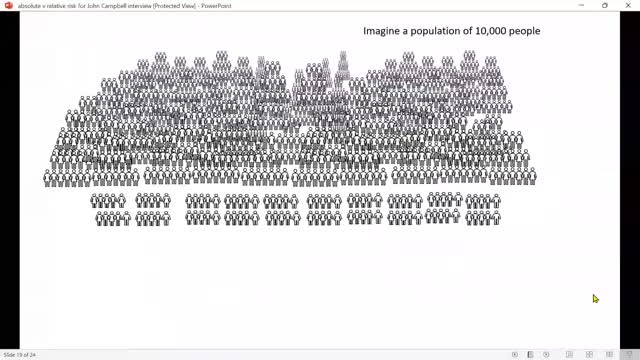Premium Only Content

Misrepresented risk in medical papers
Professor Norman Fenton, Mathematician, Professor of Risk Information Management
Professor Fenton, YouTube channel
http://youtube.com/@normanfenton81
And Sub stack
https://wherearethenumbers.substack.com/
normanfenton.com
What is risk information management?
Thinking about risk, what do we mean by absolute risk and relative risk
Sounds a bit like the level of risk can be presented in a way that gives a particular impression of a greater or a lessor risk or benefit?
Are there occasions when a vested interest might want to give an impression of an increased benefit, or reduced risk from an intervention?
How could choosing RRR versus ARR influence the impression given for adverse reactions is medical journals?
Conversely
Are there occasions when a vested interest might want to give an impression of a decreased risk from an intervention?
So will RRR always be higher than ARR?
Why can the RRR vary between populations and vary over time?
So using one of the two measures to estimate the risk/benefit ratio would lead to different conclusions?
How could risk / benefit reporting be optimised in the medical literature?
Do you think the editors of prestigious international journals are aware of the differences between RRR and ARR?
In the case of this paper from the Journal of Expert Reviews of Vaccines
Efficacy and effectiveness of covid-19 vaccine - absolute vs. relative risk reduction
https://www.ncbi.nlm.nih.gov/pmc/articles/PMC9115787/
The original phase three data gave an efficacy for Pfizer vaccine, at preventing infection with SARS-CoV-2 of 95%, but it turns out the ARR was 0.84%
Why are these figures so different?
So is it fair to say that the ‘real world translation’ of the ARR of the Pfizer vaccine over 5 to 6 months of use increased to 3.7%?
What do we mean by number needed to treat?
-
 10:28
10:28
Dr. John Campbell
9 days agoLocal doctors call for vaccine ban
31K235 -
 LIVE
LIVE
Right Side Broadcasting Network
4 hours agoLIVE: President Trump Participates in First Cabinet Meeting - 2/26/25
8,767 watching -
 LIVE
LIVE
vivafrei
3 hours agoCanadian Liberal Leadership Race TO THE BOTTOM! Florida Prosecutor Claims SELF DEFENSE? & MORE!
1,278 watching -
 LIVE
LIVE
Simply Bitcoin
1 hour agoNEW REPORT PROVES This Bitcoin Bull Run is DIFFERENT!! | EP 1191
245 watching -
 LIVE
LIVE
The Charlie Kirk Show
1 hour agoJudges vs. The People + Is DOGE Enough? + Fort Knox | Rep. Roy, Glenn, Plume, Posobiec | 2.26.2025
4,501 watching -
 DVR
DVR
The White House
3 hours agoPresident Trump Hosts First Cabinet Meeting, Feb. 26, 2025”
14.9K8 -
 58:16
58:16
The Dan Bongino Show
3 hours agoShake-Up In The White House Press Room (Ep. 2431) - 02/26/2025
638K768 -
 1:00:00
1:00:00
The Rubin Report
2 hours agoDem Looks Visibly Angry as Stephen A. Smith Points Out Failures to His Face
40.1K20 -
 LIVE
LIVE
Benny Johnson
2 hours ago🚨 Trump's First White House Cabinet Meeting LIVE Right Now | Massive News Breaking
10,837 watching -
 2:05:04
2:05:04
Steven Crowder
4 hours agoTrump Keeps Delivering | This Week’s 3 Big Wins Explained
379K168